Books
Expand your knowledge of the SETI with must-read books by leading scientists and researchers. From classics like Carl Sagan’s ‘Cosmos’ to modern analyses of UFO data and interstellar communication, these books delve into humanity’s quest to find life beyond Earth or extraterrestrial intelligence, helping to learn about technosignatures, radio astronomy, exoplanet discoveries, Fermi’s Paradox and all the concepts related to SETI.
Modern works

Xenolinguistics / Towards a Science of Extraterrestrial Language
Xenolinguistics brings together biologists, anthropologists, linguists, and other experts specializing in language and communication to explore what non-human, non-Earthbound language might look like. The 18 chapters examine what is known about human language and animal communication systems to provide reasonable hypotheses about what we may find if we encounter non-Earth intelligence. This rich interdisciplinary collection will be of interest to researchers and students studying non-human communication, astrobiology, and language invention.
Xenolinguistics brings together biologists, anthropologists, linguists, and other experts specializing in language and communication to explore what non-human, non-Earthbound language might look like. The 18 chapters examine what is known about human language and animal communication systems to provide reasonable hypotheses about what we may find if we encounter non-Earth intelligence. This rich interdisciplinary collection will be of interest to researchers and students studying non-human communication, astrobiology, and language invention.

Origins, Worlds, and Life: A Decadal Strategy for Planetary Science and Astrobiology 2023-2032
“Origins, Worlds, and Life: A Decadal Strategy for Planetary Science and Astrobiology 2023-2032” is a strategic report that outlines a roadmap for advancing the fields of planetary science and astrobiology over the next decade. The document focuses on understanding the origins of life, the evolution of planetary systems, and the potential for life beyond Earth. It identifies key research areas, such as planetary formation, conditions conducive to life, and the detection of biosignatures on other worlds. The report emphasizes the importance of prioritizing missions to Mars and the icy moons of Jupiter and Saturn, specifically Europa and Enceladus, to search for signs of life. It also advocates for extensive surveys of exoplanets to identify those that may harbor life. Technological advancements are highlighted as crucial for enabling groundbreaking discoveries and enhancing mission capabilities. The strategy calls for international collaboration among space agencies and research institutions to maximize scientific output and resource sharing. Public engagement and education are stressed as vital components to inspire future generations and foster interest in space exploration. Ultimately, the report aims to deepen our understanding of life in the universe and its implications for humanity. By addressing these goals, the strategy seeks to propel planetary science and astrobiology into a new era of discovery.
“Origins, Worlds, and Life: A Decadal Strategy for Planetary Science and Astrobiology 2023-2032” is a strategic report that outlines a roadmap for advancing the fields of planetary science and astrobiology over the next decade. The document focuses on understanding the origins of life, the evolution of planetary systems, and the potential for life beyond Earth. It identifies key research areas, such as planetary formation, conditions conducive to life, and the detection of biosignatures on other worlds. The report emphasizes the importance of prioritizing missions to Mars and the icy moons of Jupiter and Saturn, specifically Europa and Enceladus, to search for signs of life. It also advocates for extensive surveys of exoplanets to identify those that may harbor life. Technological advancements are highlighted as crucial for enabling groundbreaking discoveries and enhancing mission capabilities. The strategy calls for international collaboration among space agencies and research institutions to maximize scientific output and resource sharing. Public engagement and education are stressed as vital components to inspire future generations and foster interest in space exploration. Ultimately, the report aims to deepen our understanding of life in the universe and its implications for humanity. By addressing these goals, the strategy seeks to propel planetary science and astrobiology into a new era of discovery.

Astrobiology, History, and Society / Life Beyond Earth and the Impact of Discovery
This book addresses important current and historical topics in astrobiology and the search for life beyond Earth, including the search for extraterrestrial intelligence (SETI). The first section covers the plurality of worlds debate from antiquity through the nineteenth century, while section two covers the extraterrestrial life debate from the twentieth century to the present. The final section examines the societal impact of discovering life beyond Earth, including both cultural and religious dimensions. Throughout the book, authors draw links between their own chapters and those of other contributors, emphasizing the interconnections between the various strands of the history and societal impact of the search for extraterrestrial life.
The chapters are all written by internationally recognized experts and are carefully edited by Douglas Vakoch, professor of clinical psychology at the California Institute of Integral Studies and Director of Interstellar Message Composition at the SETI Institute.
This interdisciplinary book will benefit everybody trying to understand the meaning of astrobiology and SETI for our human society.
This book addresses important current and historical topics in astrobiology and the search for life beyond Earth, including the search for extraterrestrial intelligence (SETI). The first section covers the plurality of worlds debate from antiquity through the nineteenth century, while section two covers the extraterrestrial life debate from the twentieth century to the present. The final section examines the societal impact of discovering life beyond Earth, including both cultural and religious dimensions. Throughout the book, authors draw links between their own chapters and those of other contributors, emphasizing the interconnections between the various strands of the history and societal impact of the search for extraterrestrial life.
The chapters are all written by internationally recognized experts and are carefully edited by Douglas Vakoch, professor of clinical psychology at the California Institute of Integral Studies and Director of Interstellar Message Composition at the SETI Institute.
This interdisciplinary book will benefit everybody trying to understand the meaning of astrobiology and SETI for our human society.
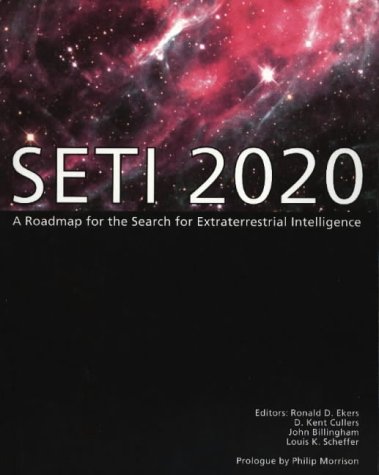
SETI 2020: A Roadmap for the Search for Extraterrestrial Intelligence
If you are interested in how researchers plan to search the heavens for signs of intelligent life, you should have this book. SETI 2020 is a new, and remarkably comprehensive study of how scientists busy with the Search for Extraterrestrial Intelligence (SETI) should direct their efforts between now and the year 2020. Distilling the work of dozens of top SETI experts, astronomers, and technology mavens, this book gives an overview of the problem of finding evidence for extraterrestrial technologies, and how to best address it. New radio telescopes consisting of large arrays of relatively small antennas are proposed and detailed. So are new types of antennas that can survey the entire sky at once. Of particular interest is the extensive treatment of optical SETI – the search for signals beamed our way using high-powered, pulsed lasers or their equivalent. A book that’s interesting for both the layman and the technically sophisticated, SETI 2020 is the definitive publication in this fascinating field.
If you are interested in how researchers plan to search the heavens for signs of intelligent life, you should have this book. SETI 2020 is a new, and remarkably comprehensive study of how scientists busy with the Search for Extraterrestrial Intelligence (SETI) should direct their efforts between now and the year 2020. Distilling the work of dozens of top SETI experts, astronomers, and technology mavens, this book gives an overview of the problem of finding evidence for extraterrestrial technologies, and how to best address it. New radio telescopes consisting of large arrays of relatively small antennas are proposed and detailed. So are new types of antennas that can survey the entire sky at once. Of particular interest is the extensive treatment of optical SETI – the search for signals beamed our way using high-powered, pulsed lasers or their equivalent. A book that’s interesting for both the layman and the technically sophisticated, SETI 2020 is the definitive publication in this fascinating field.
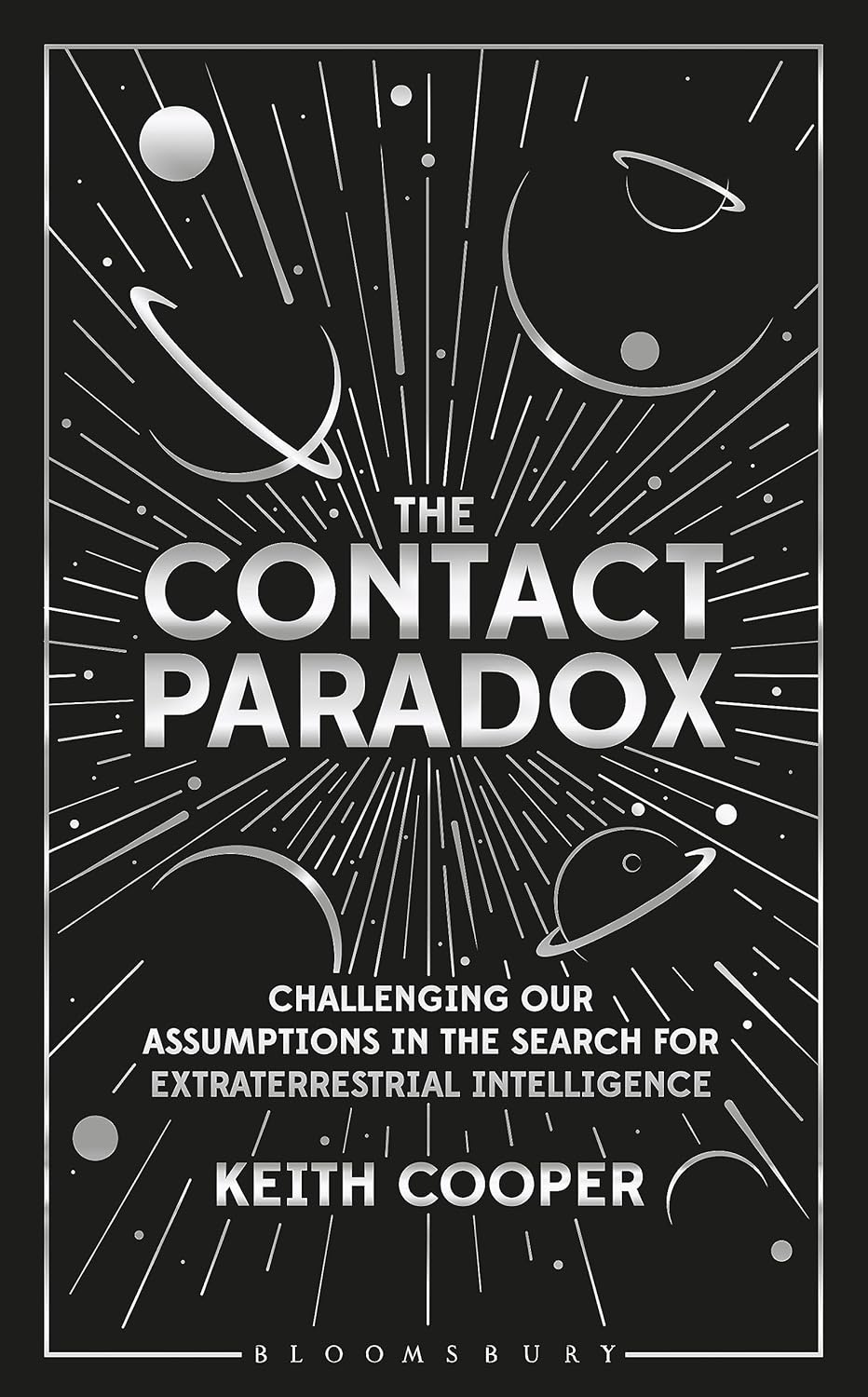
The Contact Paradox: Challenging our Assumptions in the Search for Extraterrestrial Intelligence
In The Contact Paradox, author Keith Cooper looks at how far SETI has come since its modest beginnings, and where it is going, by speaking to the leading names in the field and beyond. SETI forces us to confront our nature in a way that we seldom have before – where did we come from, where are we going, and who are we in the cosmic context of things? This book considers the assumptions that we make in our search for extraterrestrial life, and explores how those assumptions can teach us about ourselves.
In The Contact Paradox, author Keith Cooper looks at how far SETI has come since its modest beginnings, and where it is going, by speaking to the leading names in the field and beyond. SETI forces us to confront our nature in a way that we seldom have before – where did we come from, where are we going, and who are we in the cosmic context of things? This book considers the assumptions that we make in our search for extraterrestrial life, and explores how those assumptions can teach us about ourselves.

Aliens: The World’s Leading Scientists on the Search for Extraterrestrial Life
Included here are essays from a broad spectrum of the scientific community: cosmologists, astrophysicists, NASA planetary scientists, and geneticists, to name just a few, discussing the latest research and theories relating to alien life. Some of the topics include: If life exists somewhere in space, what are the odds that it evolves into something we would recognize as intelligent? What will space travel look like in the future, and will it all be done by cyborg technology? How long until we are ruled by robot overlords? (This is actually a serious consideration.) Are we simply a simulation in the mind of some supreme being, acting out a virtual reality game?
Included here are essays from a broad spectrum of the scientific community: cosmologists, astrophysicists, NASA planetary scientists, and geneticists, to name just a few, discussing the latest research and theories relating to alien life. Some of the topics include: If life exists somewhere in space, what are the odds that it evolves into something we would recognize as intelligent? What will space travel look like in the future, and will it all be done by cyborg technology? How long until we are ruled by robot overlords? (This is actually a serious consideration.) Are we simply a simulation in the mind of some supreme being, acting out a virtual reality game?
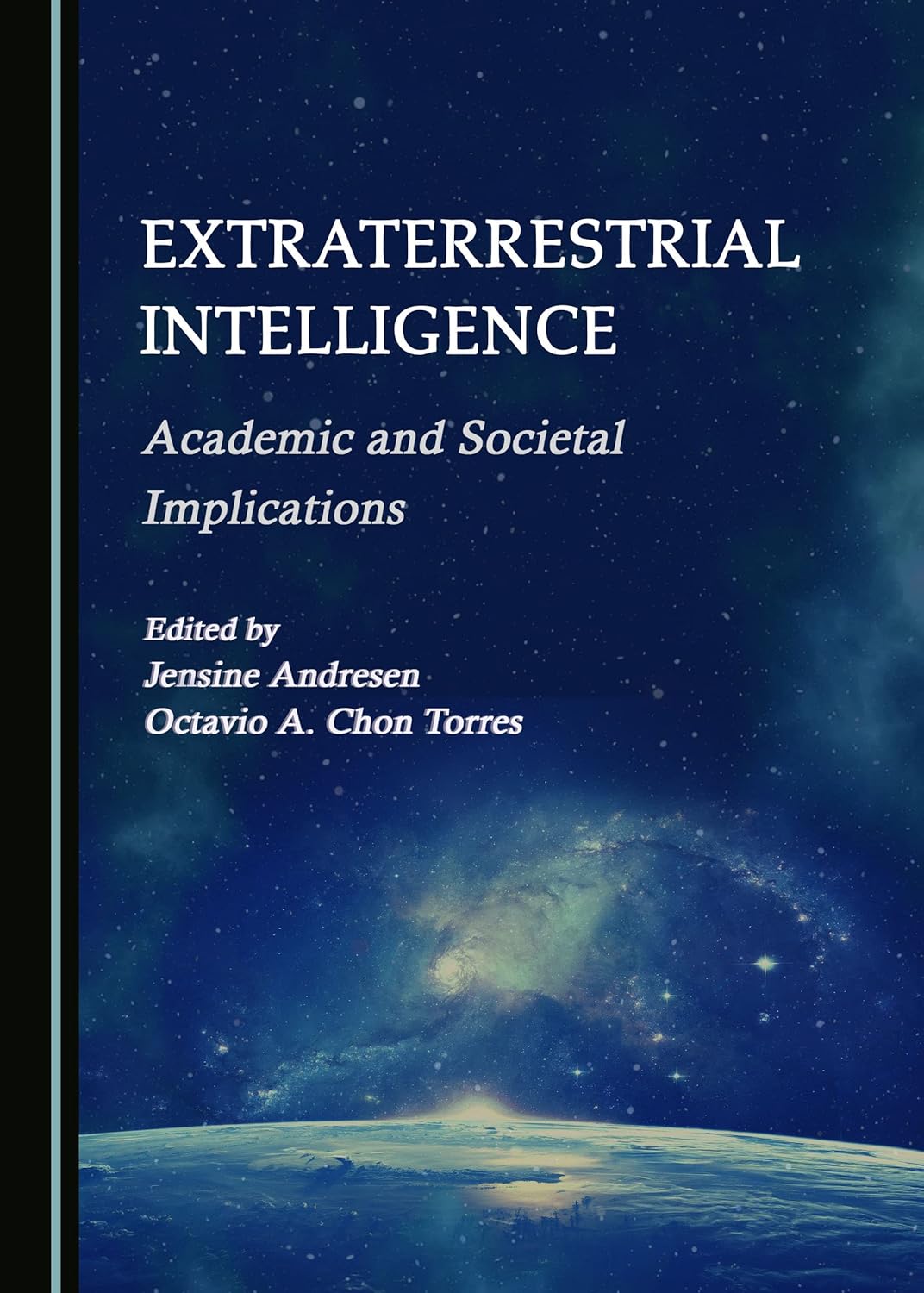
Extraterrestrial Intelligence: Academic and Societal Implications
What are the implications for human society, and for our institutions of higher learning, of the discovery of a sophisticated extraterrestrial intelligence (ETI) operating on and around Earth? This book explores this timely question from a multidisciplinary perspective. It considers scientific, philosophical, theological, and interdisciplinary ways of thinking about the question, and it represents all viewpoints on how likely it is that an ETI is already operating here on Earth. The book’s contributors represent a wide range of academic disciplines in their formal training and later vocations, and, upon reflection on the book’s topic, they articulate a diverse range of insights into how ETI will impact humankind. It is safe to say that any contact or communication with ETI will not be merely a game changer for human society, but it also will be a paradigm changer. It makes sense for human beings to prepare themselves now for this important transition.
What are the implications for human society, and for our institutions of higher learning, of the discovery of a sophisticated extraterrestrial intelligence (ETI) operating on and around Earth? This book explores this timely question from a multidisciplinary perspective. It considers scientific, philosophical, theological, and interdisciplinary ways of thinking about the question, and it represents all viewpoints on how likely it is that an ETI is already operating here on Earth. The book’s contributors represent a wide range of academic disciplines in their formal training and later vocations, and, upon reflection on the book’s topic, they articulate a diverse range of insights into how ETI will impact humankind. It is safe to say that any contact or communication with ETI will not be merely a game changer for human society, but it also will be a paradigm changer. It makes sense for human beings to prepare themselves now for this important transition.
Fundamental works
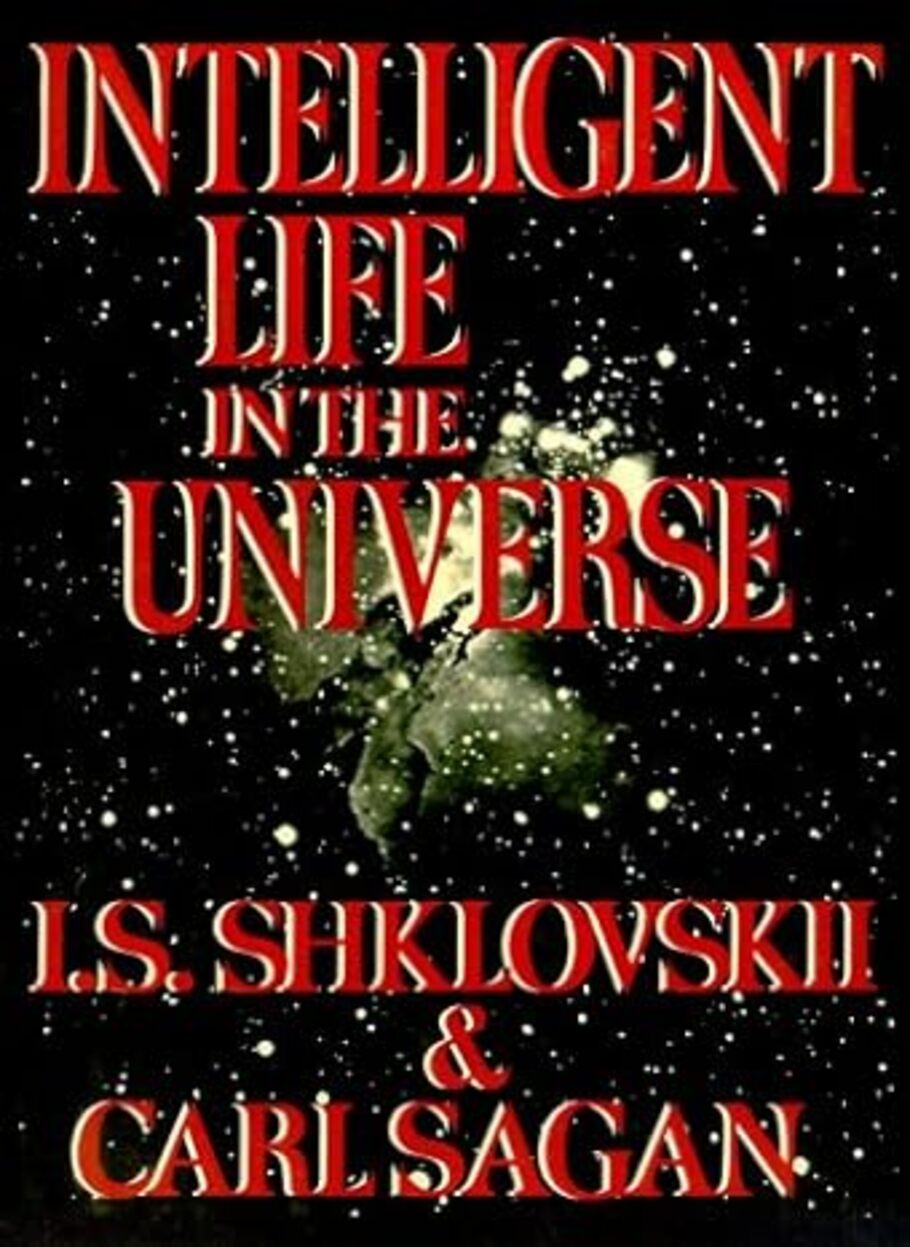
Intelligent Life in the Universe
This book, the product of a unique collaboration between a world-famous Russian astronomer and a leading American space scientist, is the first popular and modern discussion of the entire panorama of natural evolution. It covers the origins of the universe, the evolution of stars and planets, the beginnings of life on earth, and the development of intelligence and technical civilisations among galactic communities. While acknowledgedly speculative in many place — in, for example, the detailed discussions of interstellar contact — it is an outstanding summary of the present state of scientific knowledge and philosophical interest in these arresting areas of contemporary research.
This book, the product of a unique collaboration between a world-famous Russian astronomer and a leading American space scientist, is the first popular and modern discussion of the entire panorama of natural evolution. It covers the origins of the universe, the evolution of stars and planets, the beginnings of life on earth, and the development of intelligence and technical civilisations among galactic communities. While acknowledgedly speculative in many place — in, for example, the detailed discussions of interstellar contact — it is an outstanding summary of the present state of scientific knowledge and philosophical interest in these arresting areas of contemporary research.

If the Universe Is Teeming with Aliens… Where Is Everybody? Fifty Solutions to Fermi’s Paradox and the Problem of Extraterrestrial Life
In a 1950 conversation at Los Alamos, four world-class scientists generally agreed, given the size of the Universe, that advanced extraterrestrial civilizations must be present. But one of the four, Enrico Fermi, asked, “If these civilizations do exist, where is everybody?” Given the fact that there are perhaps 400 million stars in our Galaxy alone, and perhaps 400 million galaxies in the Universe, it stands to reason that somewhere out there, in the 14 billion-year-old cosmos, there is or once was a civilization at least as advanced as our own. Webb discusses in detail the 50 most cogent and intriguing solutions to Fermi’s famous paradox.
In a 1950 conversation at Los Alamos, four world-class scientists generally agreed, given the size of the Universe, that advanced extraterrestrial civilizations must be present. But one of the four, Enrico Fermi, asked, “If these civilizations do exist, where is everybody?” Given the fact that there are perhaps 400 million stars in our Galaxy alone, and perhaps 400 million galaxies in the Universe, it stands to reason that somewhere out there, in the 14 billion-year-old cosmos, there is or once was a civilization at least as advanced as our own. Webb discusses in detail the 50 most cogent and intriguing solutions to Fermi’s famous paradox.
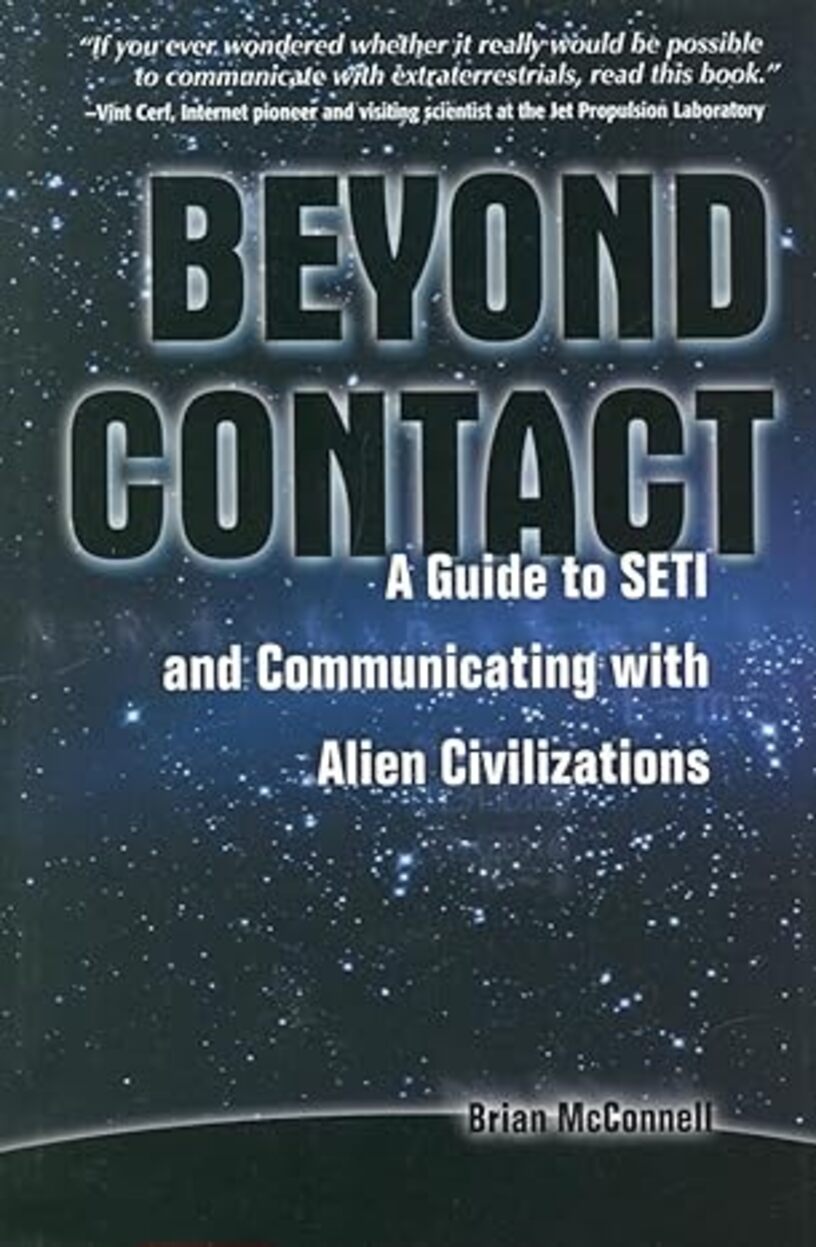
Beyond Contact: A Guide to SETI and Communicating with Alien Civilizations
In Beyond Contact: A Guide to SETI and Communicating with Alien Civilizations, author Brian McConnell goes behind the scenes and examines what goes into the search for intelligent life. SETI is a four-step process. First we have to know where to look; then we must be able to send and receive signals to that star system. Once signals arrive, scientists then need to be able to interpret those signals into something that can be understood. And although we haven’t yet received any signals (except for our own Earth-based transmissions), we’ll eventually have to figure out a protocol for responding.
The author also shows how SETI research–though often thought to be a mere flight of fancy–has spawned technological improvements in astronomy, computers, and wireless communications. Beyond Contact: A Guide to SETI and Communicating with Alien Civilizations sidesteps the “little green men” approach to take a hard, realistic look at the technologies behind the search for intelligent life in our universe.
In Beyond Contact: A Guide to SETI and Communicating with Alien Civilizations, author Brian McConnell goes behind the scenes and examines what goes into the search for intelligent life. SETI is a four-step process. First we have to know where to look; then we must be able to send and receive signals to that star system. Once signals arrive, scientists then need to be able to interpret those signals into something that can be understood. And although we haven’t yet received any signals (except for our own Earth-based transmissions), we’ll eventually have to figure out a protocol for responding.
The author also shows how SETI research–though often thought to be a mere flight of fancy–has spawned technological improvements in astronomy, computers, and wireless communications. Beyond Contact: A Guide to SETI and Communicating with Alien Civilizations sidesteps the “little green men” approach to take a hard, realistic look at the technologies behind the search for intelligent life in our universe.

Rare Earth: Why Complex Life is Uncommon in the Universe
In November 12, 2002, Dr. John Chambers of the NASA Ames Research Center gave a seminar to the Astrobiology Group at the University of Washington. The audience of about 100 listened with rapt attention as Chambers described results from a computer study of how planetary systems form. The goal of his research was to answer a deceptively simple question: How often would newly forming planetary systems produce Earth-like planets, given a star the size of our own sun? By “Earth-like” Chambers meant a rocky planet with water on its surface, orbiting within a star’s “habitable zone. ” This not-too-hot and not-too-cold inner region, relatively close to the star, supports the presence of liquid water on a planet surface for hundreds of million of years―the time-span probably necessary for the evolution of life. To answer the question of just how many Earth-like planets might be spawned in such a planetary system, Chambers had spent thousands of hours running highly sophisticated modeling programs through arrays of powerful computers. The results presented at the meeting were startling. The simulations showed that rocky planets orbiting at the “right” distances from the central star are easily formed, but they can end up with a wide range of water content. Earth seems to be quite a gem―a rocky planet where not only can liquid water exist for long periods of time, but where water can be found as a heathy oceanful―not too little and not too much. Our planet seems to reside in a benign region of the Galaxy, where comet and asteroid bombardment is tolerable and habitable-zone planets can commonly grow to Earth size. Such real estate in our galaxy―perhaps in any galaxy―is prime for life. And rare as well.
In November 12, 2002, Dr. John Chambers of the NASA Ames Research Center gave a seminar to the Astrobiology Group at the University of Washington. The audience of about 100 listened with rapt attention as Chambers described results from a computer study of how planetary systems form. The goal of his research was to answer a deceptively simple question: How often would newly forming planetary systems produce Earth-like planets, given a star the size of our own sun? By “Earth-like” Chambers meant a rocky planet with water on its surface, orbiting within a star’s “habitable zone. ” This not-too-hot and not-too-cold inner region, relatively close to the star, supports the presence of liquid water on a planet surface for hundreds of million of years―the time-span probably necessary for the evolution of life. To answer the question of just how many Earth-like planets might be spawned in such a planetary system, Chambers had spent thousands of hours running highly sophisticated modeling programs through arrays of powerful computers. The results presented at the meeting were startling. The simulations showed that rocky planets orbiting at the “right” distances from the central star are easily formed, but they can end up with a wide range of water content. Earth seems to be quite a gem―a rocky planet where not only can liquid water exist for long periods of time, but where water can be found as a heathy oceanful―not too little and not too much. Our planet seems to reside in a benign region of the Galaxy, where comet and asteroid bombardment is tolerable and habitable-zone planets can commonly grow to Earth size. Such real estate in our galaxy―perhaps in any galaxy―is prime for life. And rare as well.
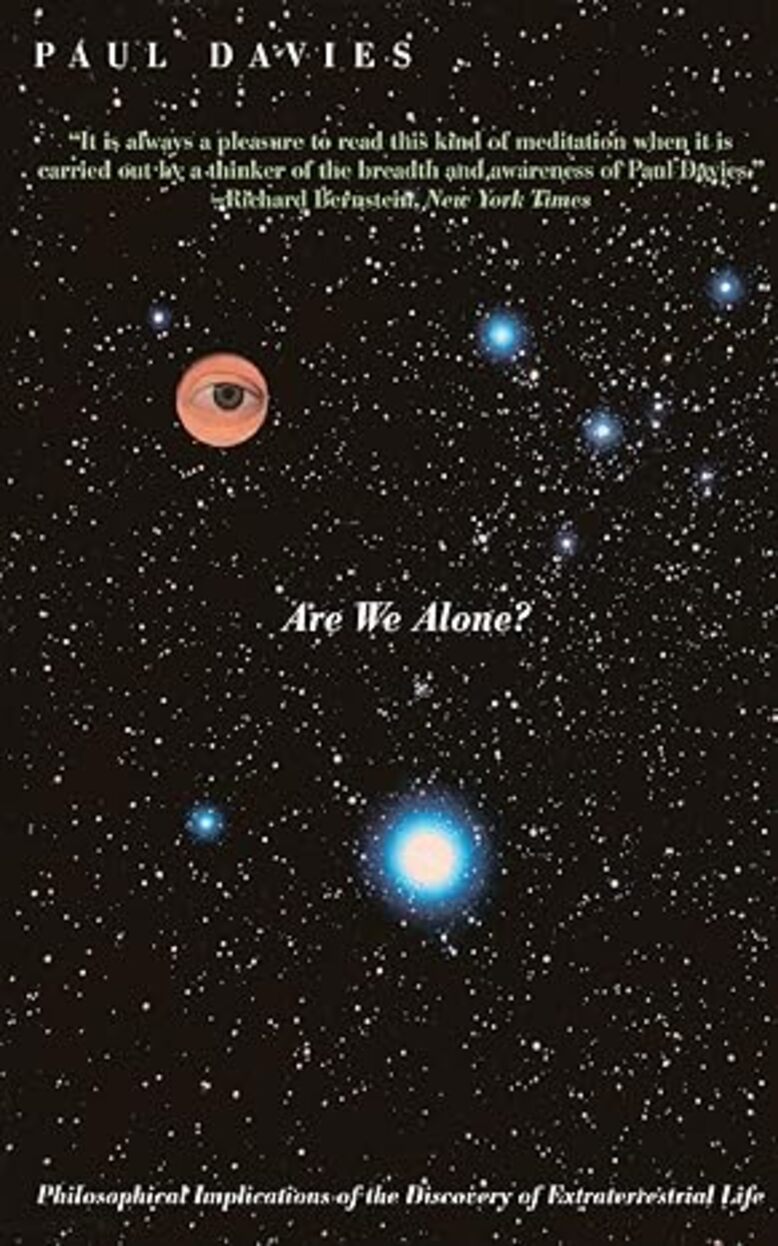
Are We Alone? Philosophical Implications of the Discovery of Extraterrestrial Life
Scientists and governments are actively searching for signs of life in the universe. Will their efforts meet with success? Award-winning author Paul Davies, an eminent scientist who writes with the flair of a science fiction writer, explores the ramifications that the discovery of extraterrestrial life would have for our science, our religions, and our worldview in general.
Scientists and governments are actively searching for signs of life in the universe. Will their efforts meet with success? Award-winning author Paul Davies, an eminent scientist who writes with the flair of a science fiction writer, explores the ramifications that the discovery of extraterrestrial life would have for our science, our religions, and our worldview in general.

Cosmic Connection: An Extraterrestrial Perspective
In 1973, Carl Sagan published The Cosmic Connection, a daring view of the universe, which rapidly became a classic work of popular science and inspired a generation of scientists and enthusiasts. This seminal work is reproduced here for a whole new generation to enjoy. In Sagan’s typically lucid and lyrical style, he discusses many topics from astrophysics and solar system science, to colonization, terraforming and the search for extraterrestrials. Sagan conveys his own excitement and wonder, and relates the revelations of astronomy to the most profound human problems and concerns: issues that are just as valid today as they were thirty years ago. New to this edition are Freeman Dyson’s comments on Sagan’s vision and the importance of the work, Ann Druyan’s assessment of Sagan’s cultural significance as a champion of science, and David Morrison’s discussion of the advances made since 1973 and what became of Sagan’s predictions. Who knows what wonders this third millennium will reveal, but one thing is certain: Carl Sagan played a unique role in preparing us for them.
In 1973, Carl Sagan published The Cosmic Connection, a daring view of the universe, which rapidly became a classic work of popular science and inspired a generation of scientists and enthusiasts. This seminal work is reproduced here for a whole new generation to enjoy. In Sagan’s typically lucid and lyrical style, he discusses many topics from astrophysics and solar system science, to colonization, terraforming and the search for extraterrestrials. Sagan conveys his own excitement and wonder, and relates the revelations of astronomy to the most profound human problems and concerns: issues that are just as valid today as they were thirty years ago. New to this edition are Freeman Dyson’s comments on Sagan’s vision and the importance of the work, Ann Druyan’s assessment of Sagan’s cultural significance as a champion of science, and David Morrison’s discussion of the advances made since 1973 and what became of Sagan’s predictions. Who knows what wonders this third millennium will reveal, but one thing is certain: Carl Sagan played a unique role in preparing us for them.
The Search for Life in the Universe
Long recognized as the Gold Standard text for astrobiology courses, The Search for Life in the Universe now appears in a completely revised and updated Third Edition. This book engages students in astronomy by presenting a great, unsolved mystery: How likely is life beyond earth, and how can we find it if it exists? The text covers the fundamentals of astronomy and astrophysics, including the discovery of more than 55 planets around other stars, and also provides an overview of biology, geology, evolution, and the possibilities of interstellar travel and communication. Written for readers with no background in mathematics, the book includes 24 color insert pages and brilliantly rendered illustrations by Jon Lomberg.
Long recognized as the Gold Standard text for astrobiology courses, The Search for Life in the Universe now appears in a completely revised and updated Third Edition. This book engages students in astronomy by presenting a great, unsolved mystery: How likely is life beyond earth, and how can we find it if it exists? The text covers the fundamentals of astronomy and astrophysics, including the discovery of more than 55 planets around other stars, and also provides an overview of biology, geology, evolution, and the possibilities of interstellar travel and communication. Written for readers with no background in mathematics, the book includes 24 color insert pages and brilliantly rendered illustrations by Jon Lomberg.

Communication with Extraterrestrial Intelligence (CETI)
In April 2010, fifty years to the month after the first experiment in the Search for Extraterrestrial Intelligence (SETI), scholars from a range of disciplines—including astronomy, mathematics, anthropology, history, and cognitive science—gathered at NASA’s biennial Astrobiology Science Conference (AbSciCon) for a series of sessions on the search for intelligent life. This book highlights the most recent developments in SETI discussed at that conference, emphasizing the ways that SETI has grown since its inception. The volume covers three broad themes: First, leading researchers examine the latest developments in observational SETI programs, as well as innovative proposals for new search strategies and novel approaches to signal processing. Second, both proponents and opponents of “Active SETI” debate whether humankind should be transmitting intentional signals to other possible civilizations, rather than only listening. Third, constructive proposals for interstellar messages are juxtaposed with critiques that ask whether any meaningful exchange is possible with an independently evolved civilization, given the constraints of contact at interstellar distances, where a round-trip exchange could take centuries or millennia.
In April 2010, fifty years to the month after the first experiment in the Search for Extraterrestrial Intelligence (SETI), scholars from a range of disciplines—including astronomy, mathematics, anthropology, history, and cognitive science—gathered at NASA’s biennial Astrobiology Science Conference (AbSciCon) for a series of sessions on the search for intelligent life. This book highlights the most recent developments in SETI discussed at that conference, emphasizing the ways that SETI has grown since its inception. The volume covers three broad themes: First, leading researchers examine the latest developments in observational SETI programs, as well as innovative proposals for new search strategies and novel approaches to signal processing. Second, both proponents and opponents of “Active SETI” debate whether humankind should be transmitting intentional signals to other possible civilizations, rather than only listening. Third, constructive proposals for interstellar messages are juxtaposed with critiques that ask whether any meaningful exchange is possible with an independently evolved civilization, given the constraints of contact at interstellar distances, where a round-trip exchange could take centuries or millennia.
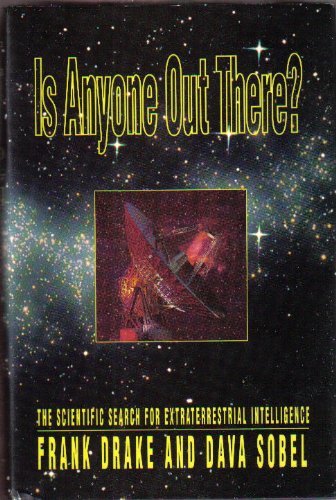
Is Anyone Out There?
In a captivating and accessible narrative, Drake and writer Dava Sobel take the reader to remote observatories around the world and behind the closed doors of international conferences dedicated to detect extraterrestrial intelligence. Some of the greatest names in science – Carl Sagan, Otto Struve, Philip Morrison, Melvin Calvin, Edward Purcell, Francis Crick, Bernard Oliver – have worked with Drake to untangle both the practical elements of detecting alien radio signals and the philosophical questions raised by the existence of other sentient beings in the universe. What do we stand to gain from interstellar contact? Which facts about ourselves do we want to communicate to extraterrestrials? How should we respond to a signal from another civilization? While maintaining an absorbing anecdotal charm, Is Anyone Out There? grapples with these questions and thoughtfully provides a clear explanation of the scientific ideas and technology that define the search.
In a captivating and accessible narrative, Drake and writer Dava Sobel take the reader to remote observatories around the world and behind the closed doors of international conferences dedicated to detect extraterrestrial intelligence. Some of the greatest names in science – Carl Sagan, Otto Struve, Philip Morrison, Melvin Calvin, Edward Purcell, Francis Crick, Bernard Oliver – have worked with Drake to untangle both the practical elements of detecting alien radio signals and the philosophical questions raised by the existence of other sentient beings in the universe. What do we stand to gain from interstellar contact? Which facts about ourselves do we want to communicate to extraterrestrials? How should we respond to a signal from another civilization? While maintaining an absorbing anecdotal charm, Is Anyone Out There? grapples with these questions and thoughtfully provides a clear explanation of the scientific ideas and technology that define the search.
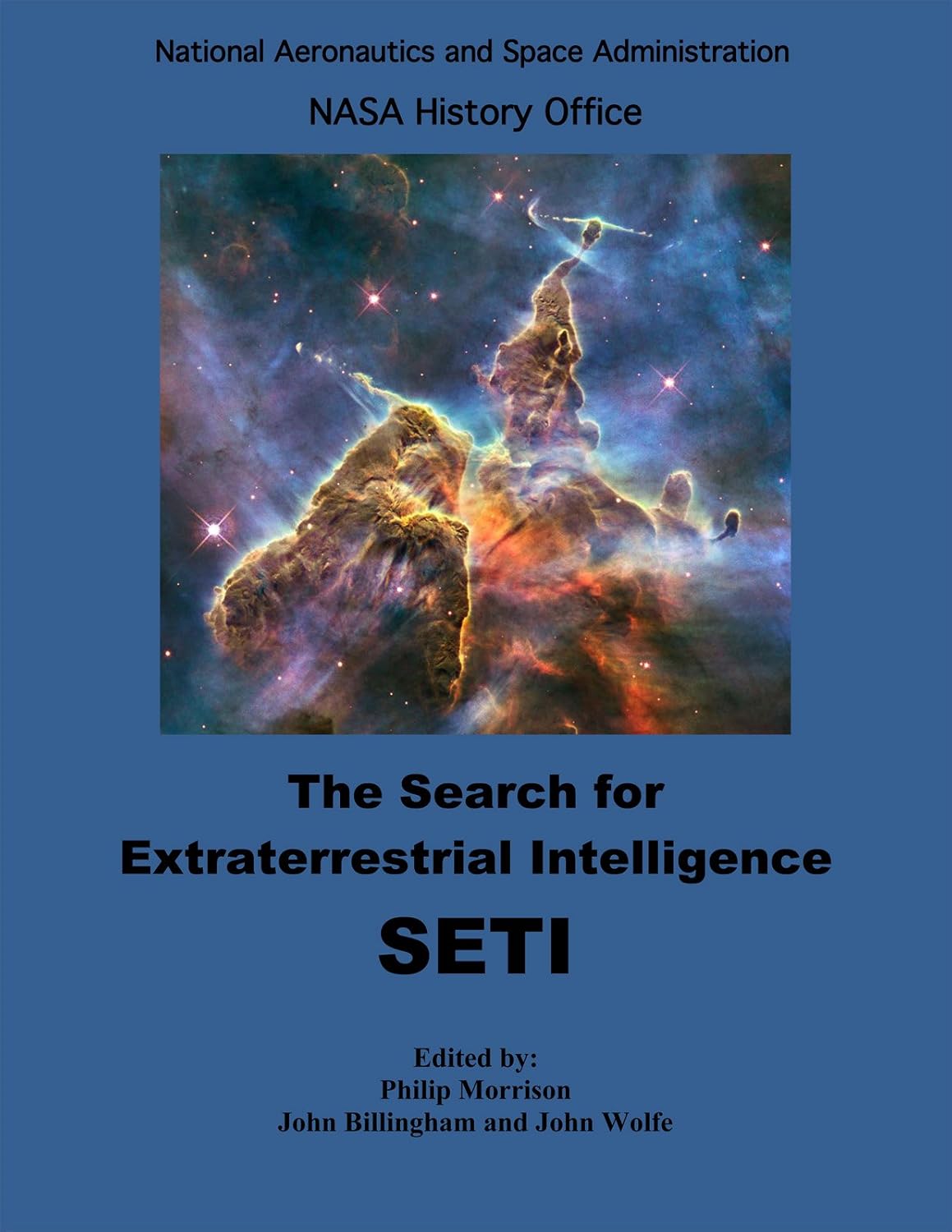
The Search for Extraterrestrial Intelligence
There are few questions that more excite the curiosity, the imagination and the exploratory bent of modern man than the one posed in this study: Are we humans alone in this vast universe? The question is usually expressed in terms of other possible intelligent beings, or other planets. We should not be predisposed to accept the proposition that we indeed are alone and unique as creatures possessing intelligence and freedom in this whole vast Universe.
This book, first published by NASA in 1977 is the findings of a series of Science Workshops. The Workshop activities were part of a feasibility study on the Search for Extraterrestrial Intelligence (SETI) conducted by the NASA Ames Research Center.
There are few questions that more excite the curiosity, the imagination and the exploratory bent of modern man than the one posed in this study: Are we humans alone in this vast universe? The question is usually expressed in terms of other possible intelligent beings, or other planets. We should not be predisposed to accept the proposition that we indeed are alone and unique as creatures possessing intelligence and freedom in this whole vast Universe.
This book, first published by NASA in 1977 is the findings of a series of Science Workshops. The Workshop activities were part of a feasibility study on the Search for Extraterrestrial Intelligence (SETI) conducted by the NASA Ames Research Center.